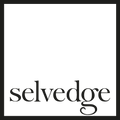
Louis Nye: Reflections and Apparitions
Louis Nye’s contribution to the show De Cuando Jugábamos at Galería Silvestre explored the structural limitations inherent in weaving - fixed widths, predetermined thread counts, and the binary logic of horizontal and vertical lines. Within this grid-like constraint, Nye sought moments of disruption. By introducing areas of loose threads, they created spaces of movement, breaking away from the rigid logic of the loom to allow for spontaneity and flow.
Below, Louis kindly shares further insight into his work:
 Apparition Reverse, 2025, Louis Nye
Apparition Reverse, 2025, Louis Nye
My Practice
When I first started weaving on digital jacquard looms, I was seduced by the possibilities to combine so many different weave patterns and work in such detail. At the time I was mainly working in painting and print, and I used the loom more as a way to execute rather than develop artworks. As I became more and more familiar with the possibilities of weave, I began to process ideas and envision works through a weaving mindset and found ways to express ideas through material, density and structure. I learned to embrace the limitations of weaving; such as the predetermined width or the vertical and horizontal meeting of threads, and enjoy the challenge of battling against this grid to create something soulful out of this mathematical setup.
 Initial Drawings for 'La Concha', Louis Nye
Initial Drawings for 'La Concha', Louis Nye
As a starting point for works, I’ve always been drawn to images that display some sense of tension, quiet drama or breakdown in order, be it between people or objects. I found it most exciting to express these concerns through weaving structure. How dense is a weaving? Or how loose? How do different weaving structures affect a woven image? Is the woven image compact and strong or loose and falling apart? Compared to other textile techniques such as embroidery, dyeing or printing, weavers construct a piece of fabric (rather than adding to it). We start with a pile of threads and we finish with a tangible object, so ideas of ‘construction’ and ‘structure’ feel very integral to weaving. I often lean on this type of vocabulary: build, support, strengthen.

In recent works I’ve been exploring how a loose weaving structure can threaten an image, as if the image could unravel at any moment. These ‘unstable weavings’ balance on the edge of an image, with the aim of using weaving not as a tool to create an image but as a way to understand an image.
Apparition Weavings
I wanted to make a series of weavings that were structurally precarious. This involved large sections of loose warp and only small sections of the warp and weft interacting, holding the threads together in an almost ephemeral state. Titled ‘Apparition’, these weavings come from 16th and 17th century etchings that depict moments of divine communication.
 Apparition Small I, Louis Nye, 2025
Apparition Small I, Louis Nye, 2025
As I was looking through etchings, I was drawn to the abstract groups of lines representing a ray of light and how they cut into etchings from outside the plate. There’s an amazing drama to these images, and it fascinates me how these momentous, indescribable moments of enlightenment are captured in such a minimal and uniform way.
 Left: Marcantonio Raimondi, Saint Roch’s staff in his left hand, from “Piccoli Santi” (Small Saints), 1500-27. Right: Johann Sadeler I, Saint Dominic, 1582
Left: Marcantonio Raimondi, Saint Roch’s staff in his left hand, from “Piccoli Santi” (Small Saints), 1500-27. Right: Johann Sadeler I, Saint Dominic, 1582
I’m neither religious nor particularly spiritual, but the process of bringing threads together to construct a fabric feels miraculous. It’s a fleeting feeling but it’s very joyful. These etchings depict something miraculous and transitory and I wanted to capture these ideas in a weaving, through a kind of structural precarity. The threads are all loose and structurally vulnerable but there’s a moment of clarity and structure as these diagonal lines appear, bringing some order to what would otherwise be chaos.
 Apparition on the loom, Louis Nye, 2025
Apparition on the loom, Louis Nye, 2025
All of these works were exhibited in Galería Silvestre, Madrid in the group show De Cuando Jugábamos with fellow textile artists Amparo de la Sota, Marta Barrenechea and Saar Scheerlings.
-
Further Information:
-
Image Credits:
LEAD: Apparition (Detail), 2005, Louis Nye
All other images as credited in photo captions.
